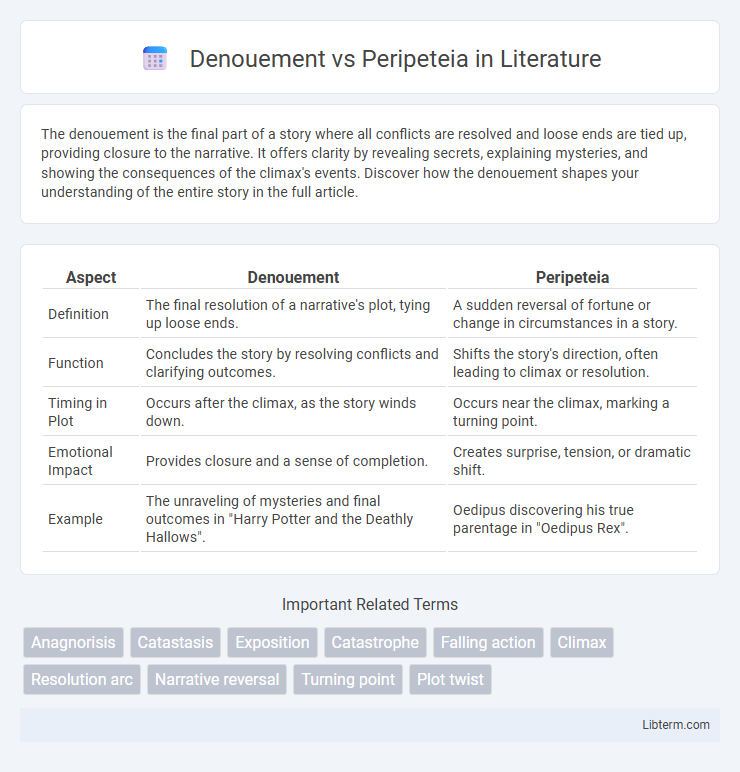The denouement is the final part of a story where all conflicts are resolved and loose ends are tied up, providing closure to the narrative. It offers clarity by revealing secrets, explaining mysteries, and showing the consequences of the climax's events. Discover how the denouement shapes your understanding of the entire story in the full article.
Table of Comparison
| Aspect | Denouement | Peripeteia |
|---|---|---|
| Definition | The final resolution of a narrative's plot, tying up loose ends. | A sudden reversal of fortune or change in circumstances in a story. |
| Function | Concludes the story by resolving conflicts and clarifying outcomes. | Shifts the story's direction, often leading to climax or resolution. |
| Timing in Plot | Occurs after the climax, as the story winds down. | Occurs near the climax, marking a turning point. |
| Emotional Impact | Provides closure and a sense of completion. | Creates surprise, tension, or dramatic shift. |
| Example | The unraveling of mysteries and final outcomes in "Harry Potter and the Deathly Hallows". | Oedipus discovering his true parentage in "Oedipus Rex". |
Understanding Denouement: Definition and Purpose
Denouement refers to the final resolution or outcome of a narrative, where loose ends are tied and conflicts are resolved, providing closure to the story. It serves the purpose of clarifying the consequences of the climax and revealing the fates of the characters, ensuring the audience gains a complete understanding of the plot's trajectory. Unlike peripeteia, which is a sudden reversal of fortune or change in circumstances, denouement is focused on delivering a coherent and satisfying conclusion.
What is Peripeteia? Key Concepts Explained
Peripeteia refers to a sudden reversal of fortune or change in circumstances in a narrative, often shifting the protagonist's fate from good to bad or vice versa. It is a crucial element in classical tragedy, defined by Aristotle as a turning point that intensifies the plot's emotional impact and drives the story toward its climax. Unlike the denouement, which is the final resolution, peripeteia occurs earlier, marking the pivotal moment of transformation within the storyline.
Historical Origins of Denouement and Peripeteia
Denouement, derived from the French word meaning "to untie," originated in classical French drama as the final resolution where plot threads are unraveled, tracing back to ancient Greek and Roman theatrical traditions. Peripeteia, a term introduced by Aristotle in his Poetics, refers to the sudden reversal of fortune or change in circumstances within a narrative, crucial to Greek tragedy's cathartic effect. Both concepts evolved from classical literature, with denouement emphasizing narrative closure and peripeteia highlighting pivotal turning points in character destiny.
The Role of Denouement in Narrative Structure
Denouement serves as the resolution phase in narrative structure, where conflicts are fully resolved and loose ends are tied up, providing closure for the audience. It follows the peripeteia, or the narrative's turning point, by revealing the consequences of pivotal actions and decisions, thus clarifying the story's ultimate meaning. Effective denouement reinforces thematic elements and emotional impact, ensuring the narrative delivers a satisfying and coherent conclusion.
Peripeteia as a Catalyst for Plot Twist
Peripeteia serves as a crucial catalyst for plot twists, marking a sudden reversal of fortune or change in circumstances that dramatically alters the narrative trajectory. Unlike denouement, which provides resolution and closure, peripeteia injects tension and surprises by disrupting the protagonist's expectations and goals. This narrative device intensifies conflict and propels the story into unforeseen directions, heightening emotional and thematic impact.
Comparing Denouement and Peripeteia: Key Differences
Denouement and peripeteia represent distinct narrative elements in storytelling, with denouement referring to the final resolution where conflicts are unraveled and loose ends tied, while peripeteia denotes the sudden reversal of fortune or twist in the plot. Key differences include timing and purpose: peripeteia occurs at the story's climax to shift the protagonist's trajectory dramatically, whereas denouement follows climax, offering closure and clarity. Understanding these terms is essential in analyzing narrative structure, particularly in classical tragedies and modern fiction.
Denouement in Classic and Modern Literature
Denouement in classic literature serves as the final resolution where plot threads converge, providing closure after the climax. In modern literature, denouement often embraces ambiguity, reflecting complex character developments and unresolved conflicts. This shift highlights evolving narrative structures while maintaining denouement's role in clarifying or deepening thematic meanings.
Famous Examples of Peripeteia in Literature
Peripeteia, the sudden reversal of fortune or change in circumstances, is famously exemplified in Sophocles' "Oedipus Rex" where King Oedipus transitions from a respected ruler to a tragic figure upon discovering his true origins. Shakespeare's "Macbeth" also demonstrates peripeteia when Macbeth shifts from a victorious nobleman to a doomed tyrant after the witches' prophecies influence his actions. Unlike denouement, which resolves the plot, peripeteia serves as a pivotal turning point intensifying the protagonist's tragic downfall.
How Denouement and Peripeteia Shape Character Development
Denouement and peripeteia play crucial roles in shaping character development by marking transformative moments in a narrative. Peripeteia, the sudden reversal of fortune, forces characters to confront new realities, prompting growth through conflict and challenge. Denouement provides resolution, allowing characters to integrate their experiences and exhibit change, completing their developmental arc.
Crafting Memorable Stories: Using Denouement and Peripeteia Effectively
Crafting memorable stories hinges on skillfully employing peripeteia, the sudden reversal of fortune that heightens emotional stakes and shifts narrative direction, creating compelling twists that engage readers. Denouement follows by providing resolution and clarity, tying loose ends and delivering thematic closure that satisfies audience expectations. Balancing these elements ensures a narrative arc that captivates through surprise while offering meaningful conclusions.
Denouement Infographic

 libterm.com
libterm.com